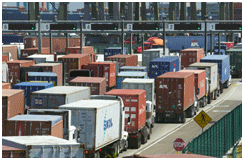(Ryan Brower is Director of Client Solutions at Weber Logistics)
It came to you in a dream about 2 years ago.
“SNEAK-ONs” – a new type of slip-on sneaker with a secret compartment. It killed in market tests, from the hood to the suburbs. You wrote a prospectus and attracted investors (Mom and Dad)… hired a CFO (Irving Meyerjack, your high school friend turned accountant)…landed a sweet deal with a Chinese manufacture…stoked the SNEAK-ON craze with some great Facebook ads…arranged ocean transport from China to LA…and, finally, set up distribution with a 3PL in the Inland Empire, east of LA.
a sweet deal with a Chinese manufacture…stoked the SNEAK-ON craze with some great Facebook ads…arranged ocean transport from China to LA…and, finally, set up distribution with a 3PL in the Inland Empire, east of LA.
The future of SNEAK-ONs looks bright!
Then you realize you’ve overlooked one important step in the supply chain – getting your goods from the Port to the distribution warehouse. Seems like a minor oversight that can be fixed with a quick phone call. But the deeper you dig into it, the more troubling the questions become.
“Wait, what’s this PierPASS thing?”
PierPASS is a non-profit organization developed in 2005 to relieve the Ports of LA/Long Beach from traffic congestion. The ports add an extra Pier PASS fee per container if your container freight trucking partner (drayman) moves goods during peak hours between 8 am and 5 pm. The cost: $123 per 40-foot-container (FEU). For the 2,000 containers of SNEAK-ONs you’ve already ordered, that’s $246,000. (Are you listening, Irving?)
Pier PASS rates are attached to the demand for a second shift of labor to keep the goods flowing thru the Ports of LA/LB. As container volumes continue to increase, the Pier PASS charge is unlikely to go away any time soon. There is no charge if your full-container is moved during off-peak hours, so the first step is finding a drayman that can provide service during the second shift.
Whew….problem solved. Or is it?
“The warehouse will receive containers at night, right?”
Well, not necessarily. Whatever the answer to the warehouse question, there are likely to be cost implications you have not considered.
If your distribution partner can accept off-hour shipments, you ideally want to get a “drop and hook” rate with your drayman. Drop and hook is when a driver simply drops his trailer in a warehouse yard and hooks up to another trailer, in this case an “empty” going back to the Port – very cost-efficient for both you AND the driver. If there is no empty to take back, the drayman will have to bobtail (tractor operating without a trailer) back to the Port, and for this will charge a fee of up to $250, depending on the distance between the drop site and the Port. That’s $500,000 for 2,000 containers.
If your distribution partner cannot accept the container at night, you’ll need to ask your drayman about the cost to bring the container to their off-dock container yard and deliver it at a later time. The cost of this “pre-pull” move can range between $75 and $125 per container, or $150,000–$250,000 for 2,000 containers. (Got your calculator out now, Irving?)
“Drayage is going to increase my time-to-market by HOW MUCH?”
Probably longer than you originally thought.
But first, the good news. Like most companies that import from Asia, you chose the LA/Long Beach port complex as your port of choice. Good decision, since the trip can be up to two weeks faster than deliveries from China to Gulf Coast and East Coast ports. That means a faster time to market and faster cash cycle. But you’ll want to understand the operating environment at Southern California ports to accurately calculate when your goods will be in your possession and ready to ship to customers.
The average turn-time for truckers at the Ports of LA and Long Beach can be over 11 hours, including:
- Turn time at the port, from in-gate to out-gate
- Time spent in queue to hook up to the bare chassis and the additional queue to grab the container
- Pre- and Post-inspection
- Round trip drive time to/from the Inland Empire (not counting the time in line to return the empty and then the bare chassis).
How does this impact getting your containers of SNEAK-ONs pulled and delivered to the warehouse? At existing conditions, you can expect one container per driver per night. 2,000 containers per year equates to about 10 moves per night (utilizing 4 off-peak gates per week). You’ll want the best drayage strategy and competitive drayage rates to prevent your profits from disappearing in a plume of tractor exhaust.
The SNEAK-ON craze and lessons learned
It’s been a long, hard road to take your product from concept to reality. Don’t get tripped up by one of the last, and seemingly trivial, steps in your global supply chain. To get your product from the Port to the distribution center quickly and efficiently, work with a partner that understands the ins and outs of Port operations in Southern California. You’ll avoid lots of headaches, and save possibly hundreds of thousands of dollars a year.
(By the way, love the secret compartment idea. Do SNEAK-ONs come in mint green?)
Download the Weber Insight:





 Capital Management
Capital Management